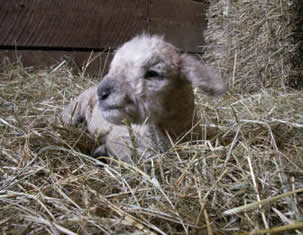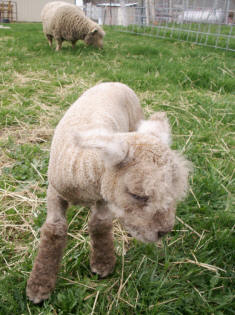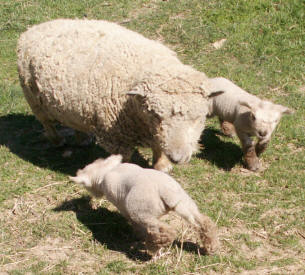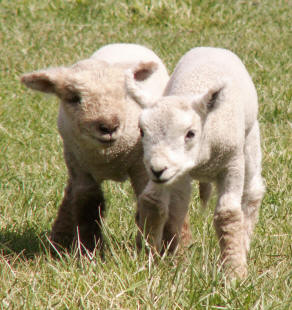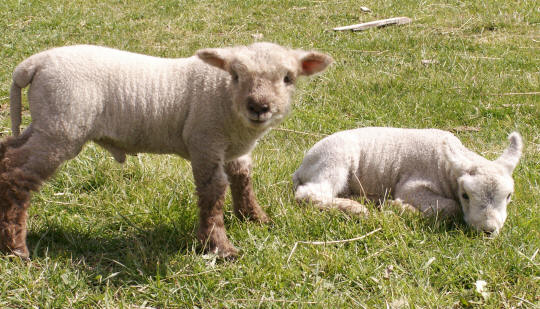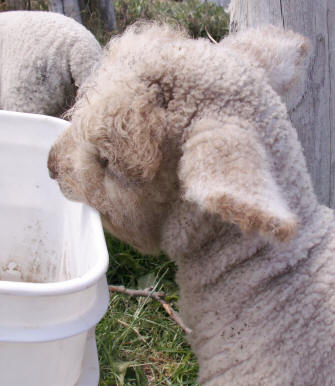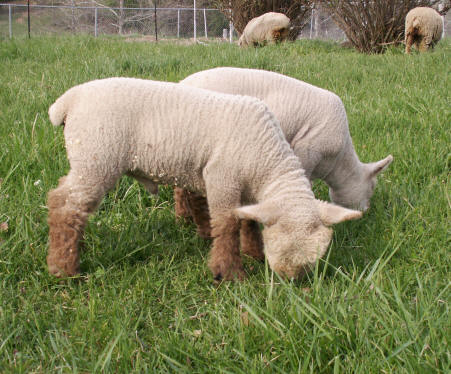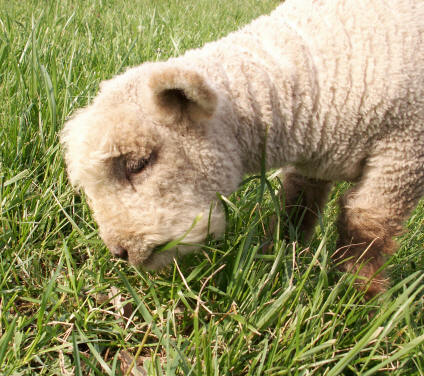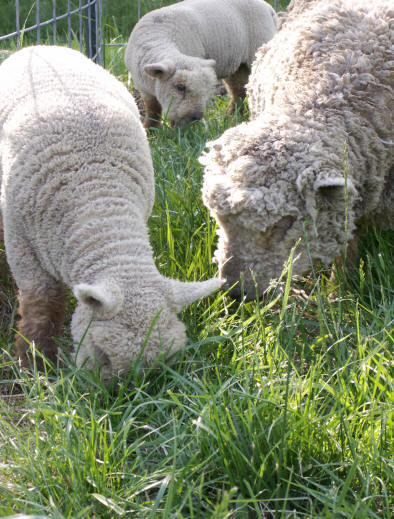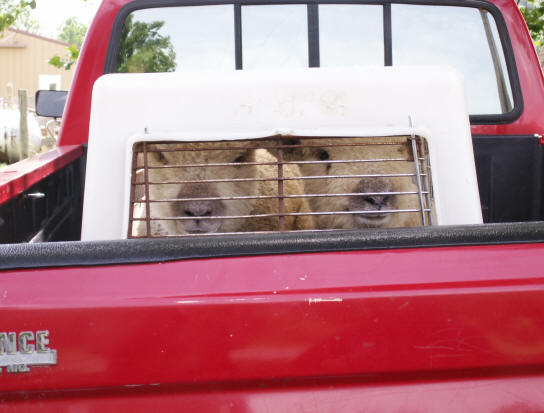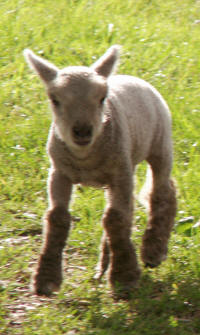I decided to keep a log about our first lambs born this year. There will be other lambs born later, but the focus of this will be on the first ones:
Day One: This set of twins were born April 1st and are our first lambs of 2007. This little male and female were shivering, weak, and not yet standing when we first found them only minutes after they were born. They arrived as a surprise to us since we’d checked the ewes just a few hours before and had not seen any clues to their soon arrival. Their mother had found herself a corner of the sheep shed to have them and did well without any assistance from us. We found her cleaning them off since they were still quite wet. We sprayed their umbilical cords with iodine since that helps offset possible infection, and then we helped them find their mother’s milk after checking to make sure she had some available. (Last year, one of our ewes did not have milk for her lamb until about a week later. We kept the lamb with her and the lamb kept attempting to nurse. We also bottle fed the lamb to supplement. Eventually, the ewe took over completely. We were glad afterward that we tried to keep them together. It doesn’t always work out that well, but we attempt to keep things as natural as possible and only step in when it is clearly for their benefit.)
When lambs are born, it is fun to listen to all the “talking” that goes on constantly between the ewe and her babies! The mother is very attentive to them. At any other time, the ewe would be very stressed to be away from the rest of the flock. But when she has her lambs, the babies become the only thing that matters to her for several days. She is very content to have a private stall for her little ones and herself. We moved her from the sheep shed to the stall by carrying her babies (close to the ground so they were at her eye level) and she readily followed “talking to them” the whole way.
Lambing time is where you can readily see how much trust you have built with the ewe. When the ewe is confident having you handle her lambs, helping them start nursing, etc., it is very apparent and well worth the efforts put forth the rest of the year. If the trust is not there, she can be quite protective of them. She will typically place herself between The Danger and her lambs, and will stomp her foot. It is much easier when the ewe stands patiently while I help the fumbling lamb achieve its first meal. This ewe is an experienced mother and knows me well, so everything went easily and she actually seemed grateful for the assistance.
Toward late afternoon, the little lambs even tried out jumping! One leap the little ewe lamb made, landed her over the edge of the water bucket I had available for her mother. Fortunately, her head stayed above water and I was able to grab her out quickly. After that, I decided to keep the water bucket outside the stall and bring it in to the ewe just when I check on them. It is not an ideal situation, but I don’t want to risk the life of a lamb. I am checking on them frequently anyway to make sure the lambs are getting enough milk. If they are quiet, that is a good sign. A hungry lamb is a crying lamb. Other signs I look for are a stomach that is more rounded than sunken in, and that the lamb is active when it is not asleep. The ewe needs very good nutrition at this stage and plenty of water to produce the milk in addition to her own needs. Our ewe has hay available, and I also hand feed sheep grain with a few alfalfa pellets mixed in. (During late gestation and during lactation is the only time my sheep are fed grain regularly. They would get too fat otherwise!) Alfalfa pellets can cause problems for sheep (an inflamed rumen or choking), so we are very careful about not feeding very many–and we always feed as part of a mixture. But the extra nutrition right now is very important. The ewe also is offered mineral salt (as always) and we put a tub of “stock lick” designed for sheep in her stall. It gives added vitamins and the ewe loves it. As soon as possible, she will be allowed to graze also.
Both lambs passed their first stools which are almost black and tarry in appearance. This is another important indicator of their health. Sometimes this may form a plug at their rear end which needs to be washed off so it doesn’t cause problems, but these two are doing fine. They are also urinating normally.
I do my last check for the night at 10:30 p.m. All look full and content. I will be able to sleep tonight.
Day Two:
This was a day of sleeping, drinking, and exploring for the lambs. It was a beautiful day, so in the afternoon I decided to open the stall door and see if the ewe wanted to venture out for a little grass. It took her considerable time to decide. She stood at the door, looking longingly at the grass, then would look back at her sleeping lambs, then look back at the grass. Finally, after both lambs awoke and were able to follow, she proceeded out slowly, talking to them the whole time. Both lambs stayed close and were obviously responding to her and talking back. She already has them trained well! I coaxed her with grain to our little vineyard which took quite a while because the lambs don’t walk very far or fast yet. Our Chesapeake Bay Retriever dog was on the other side of the chain link fence, but standing completely still and watching. I didn’t even notice him, but the ewe did! Suddenly she stomped her foot HARD. It startled me and then I realized who it was meant for. She was warning him not to mess with her lambs.
After only about 20 minutes, the lambs were panting and seemed tired. So I carried them back to the stall with their mother following me. The little ones promptly collapsed and fell asleep. The ewe checked her lambs several times. I left the stall door open for awhile in case she wanted to graze while they slept, but leaving them was not an option for her.
I noticed that today the lambs started stretching each time they got up after being asleep. This is another sign of a lamb that is doing fine. Each day they stay healthy and strong is a big hurtle at this age. The lambs are still sleeping a lot of the time, and their activity remains walking around in a “tipsy” manner. They are still not very steady on their feet or confident in their movements. When they want to turn, it seems they look in the direction they want to go, then plunge. I also noticed that they seem very lost when their mother is more than about 5 feet away. They respond to her voice by answering back, but they may head in a different direction. I don’t think they can see very far yet. Occasionally, a lamb seems to suddenly be seized by the impulse to jump, but the jump causes it to lose its balance. Then it looks surprised, as if it wasn’t responsible for what happened and doesn’t understand it. They are so comical in appearance at this age–all legs and ears with a goofy face that seems not-quite-right yet. The smile that will appear later, now looks like a half smirk. Their long little tails work like a whip when they latch onto milk. They have almost no wool as a body covering, but have extremely bushy eyebrows, and very thick cinnamon or brown “leggings”. But their mother loves them and it is hard for me not to think of them as adorable.
Day Three:
This was another warm spring day, so I opened the stall door allowing the ewe to decide what she wanted to do. She gradually moved her little family from place to place carrying on a conversation with them the whole time. When one would lag behind, she would wait until the lamb found her again. If it took too long, she would return to the lamb and then retrace her steps. The lambs are very attentive to her and stick close by. They have their little noses to the ground most of the time, sniffing everything.
Day Four:
At about 2 a.m. I was checking on some other ewes due to deliver. I brought in water for the ewe, and sat for awhile on a bale with my flashlight pointed at the ceiling, barely lighting the darkness of the barn. As the ewe took her drink, I enjoyed watching her babies sleep. They lay snuggled next to each other, completely oblivious to the world around them. They had not even awakened when I came in. The ewe finished drinking, came over to sniff my knee and tilted her head to the side as she studied my face. I have always found this to be one of the Babydoll’s more endearing traits. When they make eye contact, it often seems that they are searching for something. Then she walked to her babies, sniffed each, and satisfied, laid back down. Watching her babies sleep, and listening to the methodic chewing of her cud, I realized yet again that there are few things in life as peaceful as just spending time with sheep.
Day Five:
Our weather has turned colder. I opened the stall door mid-morning, and the little family was eager to venture out. The lambs were leaping in the stall, and once let out, went running as fast as they could across the barnyard. Then they would suddenly stop, turn, and run just as fast back to their mom to take a drink. Nursing now means security to them in addition to sustenance. I checked on the lambs from time to time throughout the day to see if they were shivering or showing any signs of too much stress. But they were always fine, so they stayed outside most of the day in spite of the cold and wind that had me eager to get back inside.
The lambs are so small, there are few fences able to contain them. Once, the ram lamb went through the fence into the pasture where the “male group” was grazing. (Four rams of various ages, and a couple wethers.) They were quite curious about him, as he slipped between them from one to the next. One ram put his head down and gently pushed him aside, then sniffed him again. I “rescued him” although it probably wasn’t necessary.
Day Six:
It was much colder today and very windy. Snow fell off and on, but did not accumulate. Again, unsure that the lambs would be hardy enough, I checked on them often. And again, they did just fine. They are so small, so delicate looking, and so much tougher than me in cold weather!
Today was another day of significance to them. We banded their tails. This is done by placing a special thick elastic band high on their tails. It is important to not place it too high (or it will interfere with important needed muscles). I also make sure their tails can cover their “privates”. I have some ewes (purchased as adults) that did not have their tails docked, and I have others that were docked so high there is no tail remaining. There are problems associated with both extremes. Left long, it is setting the ewe up for fly strike and perhaps skin problems associated with moisture being trapped in the wool. Too short, and they get sunburned in areas not designed to see much daylight. I have found that the moderate approach is the best for the sheep in every way.
Banding the tail causes the circulation to stop beyond the band. It quickly goes numb, and it always is amazing to me how the lambs don’t seem affected much by the procedure. Within a week or two, the tail will fall off while it plays. It truly sounds worse than it is–especially when done within the first week of life. The lambs also got a CDT vaccination, mainly for the tetanus aspect that is an increased risk with banding. I checked their navels at the same time. Since the umbilical cord in a newborn can be an avenue for bacteria, I looked for swelling or any other sign of infection. All seemed normal in appearance.
Day Seven:
One week old today! This is another cold day with sharp wind. There was no hesitation when I opened the stall door today. Both lambs bounded out running at full speed the length of the barnyard. The ewe ran after them calling the whole way. After about 10 minutes of this, it was as if she decided, “Enough is Enough!” and started focusing on grazing. The lambs continued their races for some time, making a pit stop for a drink as they flew by. The lambs stay together, obviously enjoying each other’s company while playing and nestle next to each other while sleeping.
Today was also the first time they met other lambs. These Mini-Cheviot/Babydoll cross lambs were also grazing with their mother. The lambs greeted each other, but did not play much today. That will come later. Once, when one of the Babydoll lambs got too close to the Cheviot ewe, she butted the lamb. Lactating ewes don’t like other lambs coming too close. It is as if they are saying, “Go find your OWN mother for your milk!”
(At this point, I am going to start posting to this log on a weekly basis instead of daily. Several more lambs have been born during this week, so my time is increasingly devoted to caring for them–leaving not as much time to write about them.)
Week Two:
We are at the end of the lamb’s second week. It has been a rainy, cold, windy, week with even some lightning, thunder, sleet, hail and snow mixed in. So there were several days that the ewe and her lambs did not see the outside of their stall. When I came to visit and take care of them, the ewe was quite vocal about her dissatisfaction! One day when she was particularly disgusted with the situation, I opened the door. She walked about 3 feet out, stood with the mud covering her hoofs and the sharp rain pelting her, then decided maybe the stall wasn’t so bad after all. She didn’t complain much the rest of the week although still greeted me with that eager inquisitive look when I would arrive. I knew the question…”Are we going to get out today?”
On the few occasions they were allowed out, this picture sums up her lambs this week:
When the lambs run, sometimes they just hit the ground with all four hoofs at once, then leap high up to land again on four hoofs…hopping along. It looks like they have springs on the bottoms of their feet. It is quite entertaining to watch and could easily consume large amounts of my time!
When they would finally settle down, they were either socializing with the other lambs,
or they were chewing on something.
The twins still always sleep together. One day, the ram lamb was intent on chewing and working over a piece of wood he had found. He was also pawing at it, although most of the time, his hoof would miss the wood and just paw the grass. His sister decided it was time for their nap, so she came over and laid as close to where he was working as she could. She seemed to be trying to give him a hint. He just continued chewing on the wood and pawing. Several times, he pawed her nose accidentally. Yet, she never moved. They are so used to each other and in tune with each other! If I had touched her, I’m sure she would have been startled. She knows me well, but I am not her brother!
As you can tell, they have gained a lot of muscle this past week. It is surprising to pick them up because it seems that they are gaining weight by the minute. They are still getting all their nutrition from their mother, but there is a lot of interest in the grass and chewing so they are getting ready to help her meet their appetite needs.
Week Three:
The lambs continue to grow and gain strength. This was a week for socializing. They run as a group with the other lambs, playing, jumping on, and pushing each other around with their heads. The ewes graze alone and seem less concerned about their little ones. The ewes seem to have one priority–eating enough to keep their babies well fed. The lambs seem to have one priority–converting the food to energy and getting rid of it.
The ewe emerged from winter with a fairly clean, full fleece this year. Within the past week, her back has started to look dirty and bits of fleece are pulled out in places. The reason has become clear. When the ewe lays down in the stall at night, the babies play “king of the mountain” on her. A few mornings, I have found one or both still asleep on her back when I came to do chores.
The ewe lamb has become increasingly interested in grass and spends a lot of time with her head to the ground nibbling. She is still not pulling and biting it off like her mother does, but rather seems to be fascinated by the texture of the blades in her mouth. Another ewe lamb has also become interested in eating this week and the two of them often work on the same blade of grass. I don’t know why that is, since there are plenty others. Maybe they just like sharing. At other times, they push each other with their heads as they look for another blade of grass to share.
The Mini-Cheviot/Babydoll cross lamb (on the right) lost her tail (beyond the point it was banded) earlier in the day this picture was taken. The following day, the little ewe lamb (on the left) lost hers. This is a good picture for illustrating how the process of docking progresses. Beyond the first few minutes after putting the band on, they never felt anything beyond the band because it quickly went numb. They never realize when their tails fall off.
The little ram lamb still has no serious interest in eating grass. He is much more interested in socializing and racing around the barnyard. Hills are great fun to all the lambs–up and down, down and up, again and again. Unless he is asleep, he is constantly on the move.
Week Four:
The lambs have discovered the purpose of grass!
They are also growing while remaining as cute as ever…
Week Five:
The lambs are eating grass quite regularly now, so this week I also made grain available to them in a “creep feeder”. This is a special area where the lambs can easily go, but the older sheep cannot. Even though they have the grain available all the time, they do not gorge on it as the older sheep would. It does give them opportunity to push each other around with their heads though. In fact, this new game of pushing is so much fun for them, they usually forget about the food. Some of the ram lambs are taking this to the next level–each backing up slowly and then charging at each other with heads down. But it doesn’t seem like they are ready to put their full strength and weight into fighting yet. They remind me of little boys arm wrestling.
Farm equipment has become quite fascinating to the lambs this week also. They explore what they can, then jump on and off.
Anything that is elevated is used to play “king of the mountain”. Any sheep lying down is fair game. The mothers are much more tolerant of this than the other ewes. When another sheep is used, she will leap up quickly, clearly indignant–scattering the lambs in every direction. But by that time the lambs are out of reach and off to the next adventure. It seems that lambs are raised with much more tolerance and patience than discipline, but that is not always by choice. The wool on the ewes’ backs are starting to look ragged. I’ve decided to try to schedule shearing for much earlier next year.
One funny sideline story from this week: Our Great Pyrenees puppy (only 8 months old, although quite big already) got herself in a very precarious situation. I am not sure exactly what happened. All I know is I came through the gate, then heard a funny noise. I turned around to find her draped over the top of our Miniature Cheviot ewe. I quickly took the picture although I’m sure I was shaking from laughing. The Pyr stayed completely limp–just looking around, obviously trying to figure out how to get off without hurting the sheep. The sheep trusted the dog enough that she wasn’t concerned. I ended up pushing down the ewe’s head and making her back out from under the dog. I cannot praise this breed of dog enough. We have two, and they are both absolutely wonderful!
“Do you think this stole goes with my coat?”
Week Six:
Grazing, playing, nursing, grazing, playing, nursing, grazing…
The lambs are looking great, but their mother’s wool is starting to look quite ragged. Too much “king of the mountain” played on her back! She is also starting to lose weight. She grazes constantly all day and I am supplementing her with grain. Her belly is distended every evening from filling up with grass, yet I am feeling her backbone more when I “score her”. That is done by feeling her backbone and the flesh on either side of it. When sheep still have their wool, it can be difficult to truly see how thin or heavy they are. That wool coat hides a lot! Also, as in the case with this ewe, a sheep can look quite plump in the evening after coming in from a day of grazing, and yet be losing weight. That is where “scoring” becomes a very useful tool. I will try to compensate for the toll her lambs are taking on her, by increasing her grain.
Week Seven:
This picture is taken in our front yard where we have a small orchard and a wide variety of ornamental plants. Babydoll sheep are known to be useful in orchards and vineyards for organic weed control. This is mainly because of their short stature–not because they dislike nibbling. As you can see, there is one sheep working on the lower leaves of the apple tree. However, they do not “gird” our trees as our Mini Cheviot and Shetland sheep would do quickly.
For our uses, the Babydolls work well. I like having the lower parts of our trees and bushes “pruned”. It makes them easier to mow around (the few times that is needed) and I think they look better. For other plants, it is a give-and-take situation. They enjoy my rose bushes, but they also eat the wild “hedge roses” along the fence-lines that we have never been successful at eradicating. They nibble at my hostas, but have also eliminated most of the dandelions (which they love). Yesterday, they were seen eating poison ivy along the creek bank! I am learning their likes and dislikes so when an ornamental plant dies I replace it with one of their “dislikes”. If I lose a couple more rose bushes this year, they will be replaced with peonies. Like all successful relationships, there is compromise. They are teaching me how to have a pretty yard AND have sheep to help weed and mow it.
Earlier in the season, the Babydolls did a wonderful job of cleaning up the vineyard “floor”. Now that the vines are budding, the sheep have been moved elsewhere. Later, when the vegetation needs to be pruned back, they will be brought back in. As the grapes ripen, they will be taken out again.
The usefulness of these little sheep is dependent on being placed in the right environment at the right time. The sheep are going to do what they do naturally–and that can be considered highly productive or a destructive nuisance, depending on where the manager chooses to graze the sheep, and when. Ultimately, they are what they are–it is up to us to use them in a way that can also be beneficial to us.
Week Eight:
Weaning time is here for the boys! Although people often think that vaccinations, banding tails, neutering the males, and placing ear tags are traumatic, experience has taught me that they are very insignificant events in the life of a lamb, compared with weaning. The bond a lamb has with his mother and sibling is very strong by this time. They are used to sleeping together and have a lot of verbal and physical contact throughout each day. Although it seems that milk is the need, at this age the psychological needs are much greater. Nursing has become a comfort more than a means for sustaining life. The lamb spends most of his day grazing and drinks water frequently. I have been also supplementing his diet with a little “grower” feed. (From what I have learned, lambs seldom acquire “overeating disease” when pasture grazed, so I do not like to encourage a diet high in grain.)
To minimize the stress of weaning, I put the boys in a pen within the larger ewe’s pen. They are able to still interact with their mothers and sisters, but unable to nurse. During the first night, I noticed that the ewes slept by the pen, providing comfort at night. The boys spent the first couple days calling a lot, but the ewes seldom answered back. When the ewes (and remaining lambs) were allowed out of the pen in the morning to graze, they left the boys without a look back. Those are the signs I am watching for. If the ewes readily leave their lambs, they are physically ready for weaning to happen.
The reason I leave the ewe lambs with their mothers for a little longer (all twins this year were boy/girl combinations), is to prevent mastitis in the ewe (decreasing the demand for milk gradually). I am also slightly decreasing the amount of grain I am giving the ewes, to slow down the milk production. They are thin, so this is a fine balance. I watch the ewes closely for any signs that they may be having problems, since they are my main concern at this stage. They all appear energetic and bright-eyed so far.
By the third day, the boys are playing with each other much more, and although they still enjoy interacting through the fence with their families, they seem content with their new routine and playmates. The ewes don’t bother with sleeping next to the pen, so they must sense their little boys don’t need them as much anymore.
Week Nine:
The ewe lamb was weaned from her mother this week. It went well, with little protest from the lamb nor her mother. It seems both were ready.
Week Ten:
The lambs got their “earrings” this week. They consist of the scrapie tags that are necessary for any sheep leaving the farm. I do not like to put them in until the lambs are weaned, because I feel it is too rough on their ears while they are nursing. I would rather insert them later than have torn ears. They are held close while it is done and immediately offered a handful of grain afterward. When released, most come right back for more petting or more grain. The “trauma” lasts a couple seconds and forgotten in about the same amount of time.
The lambs are also given their CD&T vaccinations, and their hoofs are trimmed for the first time. Most need very little trimming, but it is good for them to get accustomed to the procedure. The lambs will need another CD&T booster in about 4 weeks. Then they should get a booster yearly (in the spring). When the ewes become old enough to have little ones of their own, the yearly CD&T booster will be given about 3 weeks before lambing so the immunities are passed on to the babies. (I do not allow my ewe lambs to be bred until they are at least 18 months old since I don’t want them lambing before they are two. It takes them that long to achieve adult size, and before that I feel the risk is too great for problems.)
Week Eleven:
This week the older sheep got sheared. The little ones spent the week enjoying each other, eating, and sleeping. When I am with them, the little ram patiently stands the closest so I will pet him. The little ewe lamb is also friendly, but just a bit more timid. This is the usual behavior. It is also why wethers make such wonderful pets!
Week Twelve:
This week I purchased another flock that included more ewe lambs. The existing lambs quickly taught the newcomers to run to me when I call. It is so much fun to watch all their little fuzzy heads pop up from the grass and then have them come bouncing as fast as their little legs will take them!
This week, the lambs got a dose of UltraBoss on their backs to help keep them free from any external parasites. They also got a dose of de-wormer for the internal ones. Worms can be a real problem for sheep so periodic treatment is important. On the other hand, using de-wormers too much can lead to resistance. So that is an issue that many shepherds spend time weighing over. There is no clear-cut solution, and people take many different approaches. Personally, I like a combination of working to keep the sheep healthy (so they can tolerate any problems better), rotating their pasture areas to help break the worm cycles, removing most of the manure daily from their night pens, and de-worming at least three times a year. (My typical schedule is once close to lambing, another soon after the lambs are weaned, and another late summer right before I put the rams in with the ewes for breeding season.) If I were to see any sheep seeming a bit “off”, or if I noticed the tissue in the eyelid area looking pale, my first thoughts would be about de-worming again.
Week Thirteen:
Preparations are being made for the little ram lamb to go to his new home. Since he will be going out-of-state, he (and the ewe lamb he will go with) had to have veterinarian exams and a health certificate so they could be transported. Since there were only two this time, I was able to take them to the vet’s office in a dog crate. The little ram did very well on his first trip away from the farm. When the vet was listening to his heart with a stethoscope, the little guy started nuzzling his head against the vet’s head. We all had to smile.
As we headed back home afterward, we had to wait for a long train to pass. I wondered how the lambs were doing with the train whistle, the exhaust fumes as the engine passed, and the vibration and loudness of sitting so close to the passing train. But when we got home, they appeared to be quite relaxed about the whole adventure.
My daughter asked them, “Well, how did your visit to the vet go?”
“Baaaaad”, they answered together, grinning as usual.
As soon as they got out of the crate and were lifted to the ground, they ran calling to their friends and immediately resumed their favorite pastime–munching grass.
Week Fourteen:
Well, the Big Day has come! The little ram is going to his new home. He gets his final CD&T vaccination early this morning in preparation to leave.
He has changed from a frail, teetering newborn to a confident, friendly young ram during these past fourteen weeks. His sister is staying in our flock, claimed by my daughter as her payment for being my assistant shepherd this year. I am glad she picked this little ewe, who she named “Shirley” after Shirley Temple.
It is always hard for me to see the little ones go. Each has its own personality and as they get older, the differences become more distinct. This little guy has always been the second to greet me when I enter the lamb pen. The ewe he will leave with, was always the first. She would be more overt about wanting to be petted, while he would stand quietly next to my leg, patiently waiting. Rubbing him under his chin and on the front part of his chest would cause him to close his eyes and get him so relaxed he would almost fall asleep. I will miss him.
But I know he is going to a good home where he will be loved by a whole family, and especially one very young little girl who wants sheep sooooo much and has waited sooooo long for them. Even though my short fourteen weeks with him are over, they have been very enjoyable. Now it is someone else’s turn to experience the happiness I’m sure he will bring…
I watch the young ram, his female friend, and their new family pull out of the driveway. Then I turn to check on my latest baby–another little ram that was born this week as a complete surprise (even to our shearer who had said he was sure the mother was “just fat”). I pick him up and hold him while his mother munches peacefully beside me. He gets very quiet as I stroke him under his chin, and then he closes his eyes.
Life as a shepherd is good!



